Embark on your next professional chapter with confidence by utilizing our Sample Relieving Letter Template, a perfect adjunct to your resignation letter. This template is a critical asset for any departing employee, ensuring the resignation process concludes on a professional note. Tailored to articulate your departure details succinctly, it captures the essence of a respectful release from your position. Providing clarity and formality, our template assists in maintaining amicable ties with your former employer, while affirming your departure with poise. Incorporate this vital document into your resignation strategy to navigate the transition smoothly, leaving a positive and lasting impression that can bolster your professional trajectory.
1. Sample Relieving Letter Template
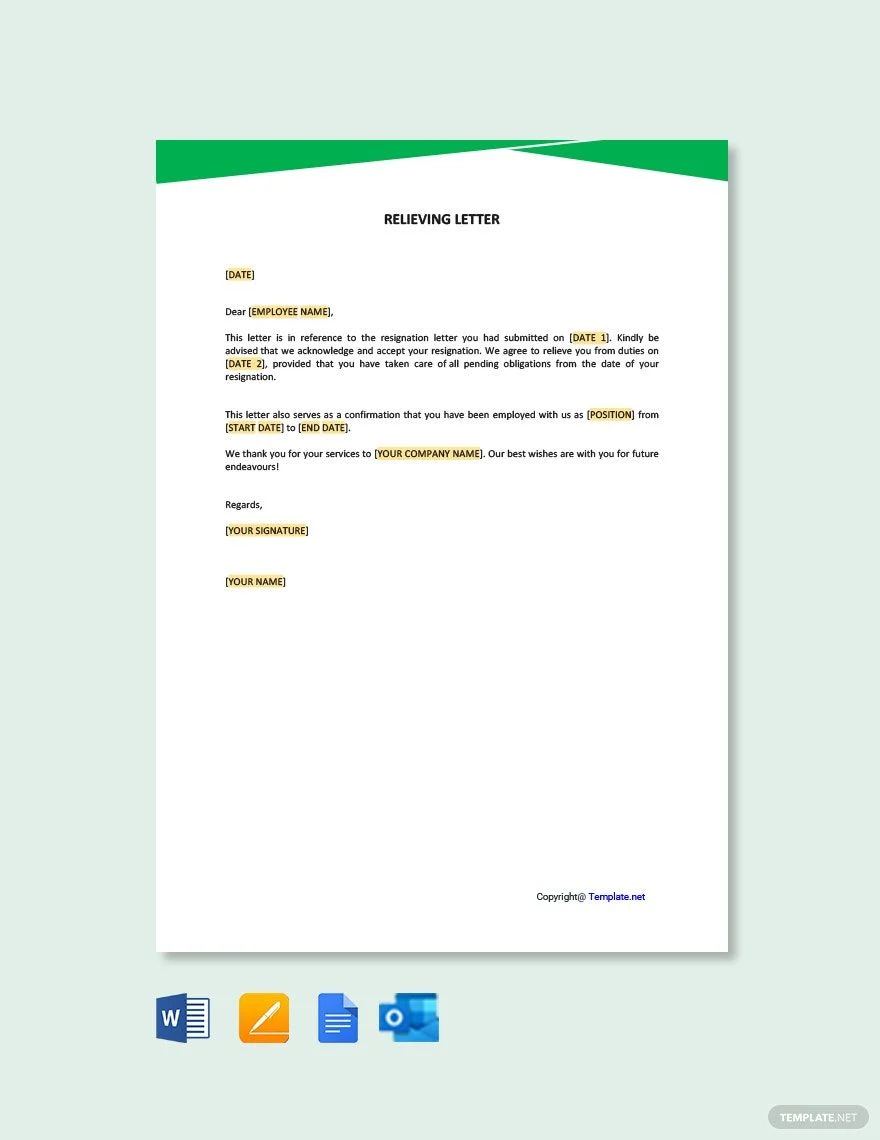
2. Relieving Letter after Resignation
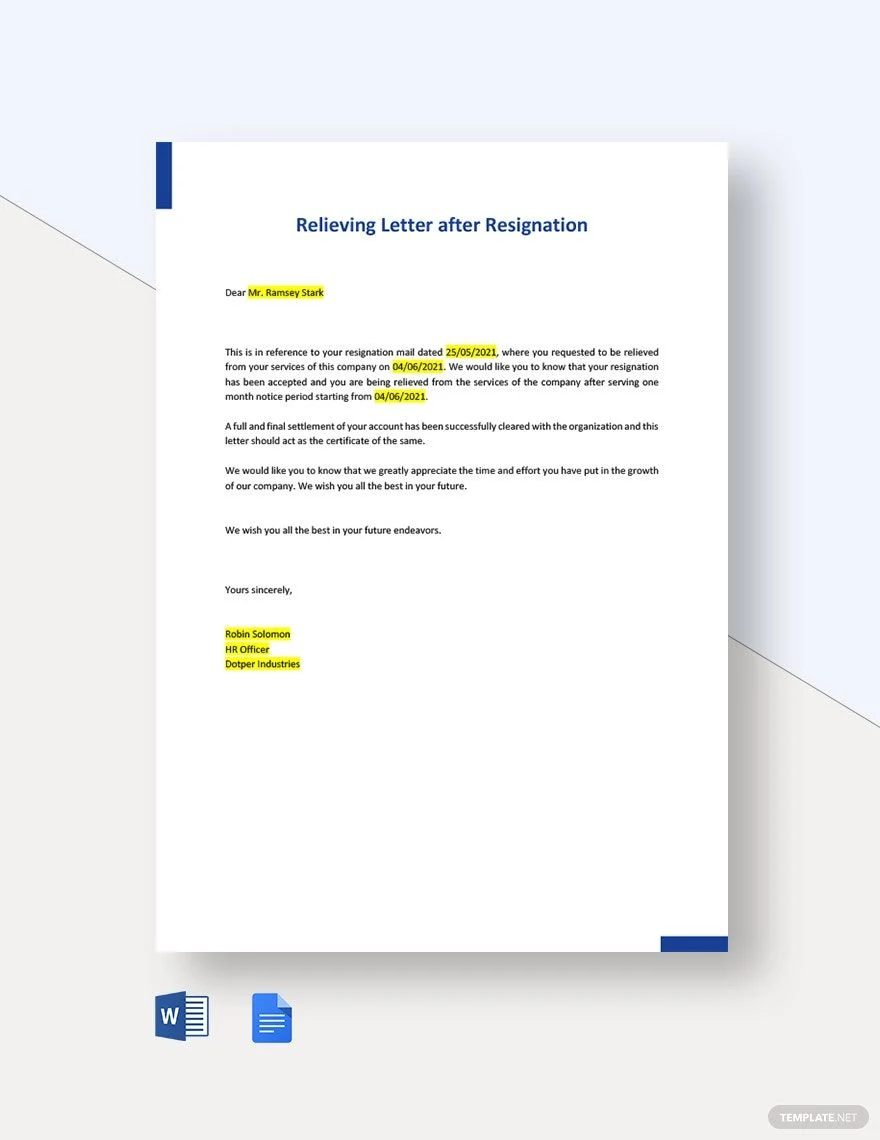
3. Formal Relieving Letter

What Is a Relieving Letter?
A relieving letter is a formal document issued by an employer to an employee who is leaving the company. It serves as an official acknowledgment that the employee has fulfilled their duties and is being relieved of their responsibilities. This letter is a vital component of the resignation process, ensuring a smooth transition for both the employee and the employer.
When an employee resigns, it is customary for them to submit a resignation letter, outlining their intent to leave the company and usually providing a notice period. During this period, the employee may have to hand over their responsibilities to a successor or to the management. Once all the tasks have been completed and the notice period has ended, the employer provides the relieving letter as a confirmation that the employee has been formally released from their job duties.
The contents of a relieving letter typically include the employee’s name, position, and date of resignation. It also states the last working day of the employee and confirms that all due processes have been completed, such as the submission of company property, clearance of dues, and any other formalities. The letter will often express good wishes for the employee’s future endeavors, maintaining a tone of professional courtesy.
From the perspective of the employee, the relieving letter is an important document for future employment. It acts as proof that they left the previous organization on good terms. For the new employer, it serves as a reassurance that the candidate has no pending obligations that might interfere with the new job. It’s particularly significant in countries like India, where it is a standard part of the employment process and often required when joining a new company.
Having a relieving letter can also be beneficial if there are any disputes about the terms of the employee’s departure. It serves as a formal record that the employer has no objections to the employee leaving the company. In essence, it closes the chapter of employment with a particular employer and enables the individual to pursue new opportunities without any baggage from their previous job.
4. Company Relieving Letter
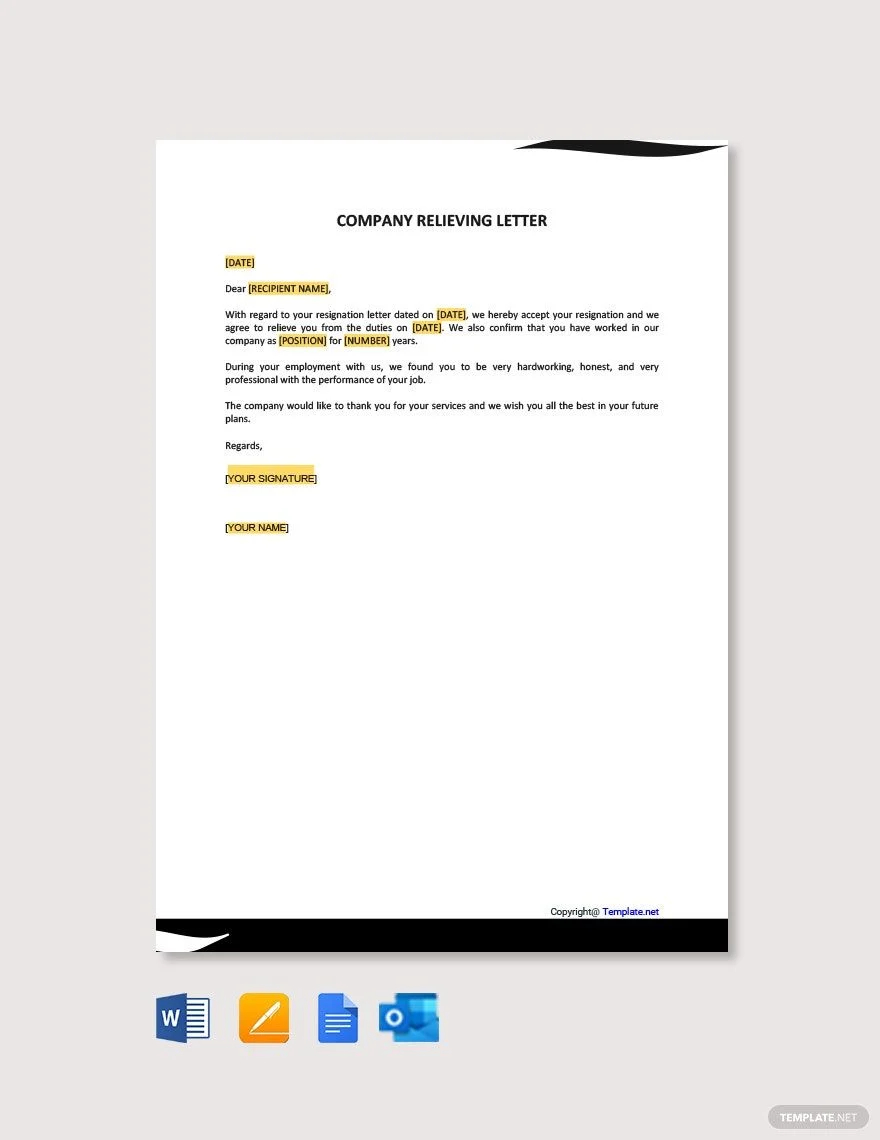
5. Immediate Relieving Letter
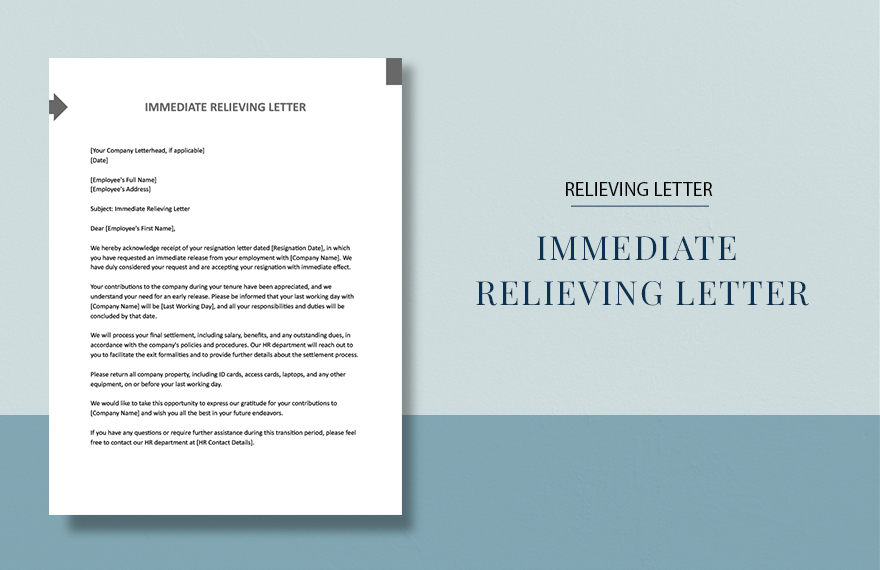
Points to consider when making a relieving letter
When crafting a relieving letter, it’s essential to ensure that the document communicates the necessary information clearly and professionally. Here are key points to consider when creating this important piece of correspondence:
1. Professional Format:
The relieving letter should be formatted professionally, using a standard business letter format. It should be typed on company letterhead, which adds to the letter’s authenticity and formal nature.
2. Date of Issuance:
The letter should be dated accurately, reflecting the actual date of issuance, which is typically the employee’s last working day or shortly thereafter.
3. Employee Information:
Include the full name of the employee, their designation, department, and employee identification number if applicable. This personalizes the letter and helps avoid any confusion regarding the recipient’s identity.
4. Resignation Acknowledgment:
Clearly state that the employee’s resignation has been accepted, noting the date the resignation letter was received and the effective date of resignation.
5. Clear Relieving Statement:
The main body of the letter should explicitly state that the employee is being relieved from their duties and mention the effective date of relief.
6. Completion of Obligations:
Confirm that the employee has completed all work assignments and has handed over all company property, if applicable. It should also be mentioned that all outstanding dues have been settled.
7. Positive Tone:
Maintain a positive and courteous tone throughout the letter. Even if the employee’s tenure was challenging, it’s important to part ways on a positive note.
8. Well Wishes for Future Endeavors:
Wish the employee success in their future career, which reflects well on the company’s culture.
9. Issuer’s Details:
The letter should be signed by the appropriate authority, typically someone from the Human Resources department or the employee’s immediate supervisor. Include the name, position, and contact details of the person issuing the letter.
10. Proofreading:
Before issuing, thoroughly proofread the letter to correct any grammatical, typographical, or factual errors. An error-free document maintains the professionalism of the company.
11. Legal Compliance:
Ensure that the letter adheres to the employment laws and regulations applicable in the region where the company operates. It should also respect the terms and conditions stated in the employee’s contract.
12. Prompt Delivery:
The relieving letter should be prepared and delivered to the employee promptly, often on the last day of work, to avoid any inconvenience to their future employment plans.
By keeping these points in mind, the resulting letter will serve as a proper and professional document that can be used by the employee for future professional needs, such as job applications and background verifications.
6. Relieving Letter to Manager
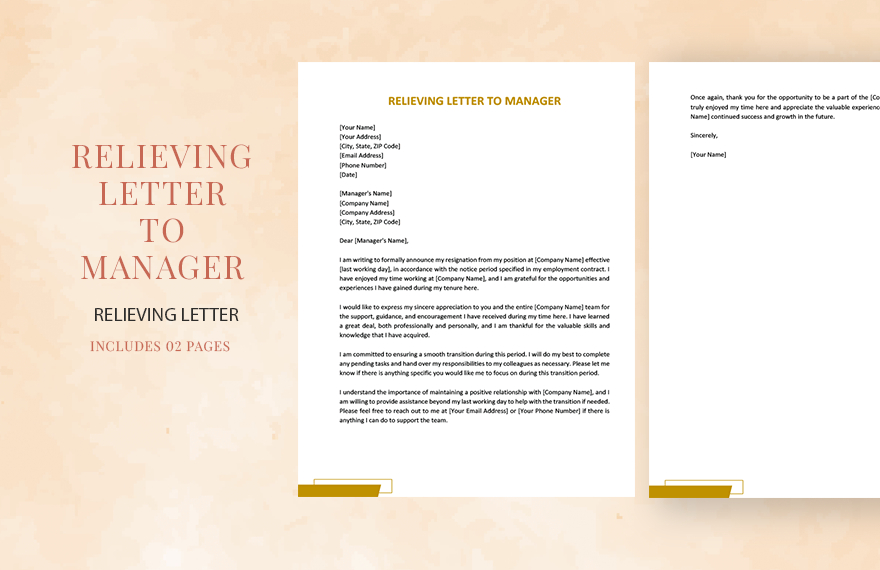
6. Employee Relieving Letter Template
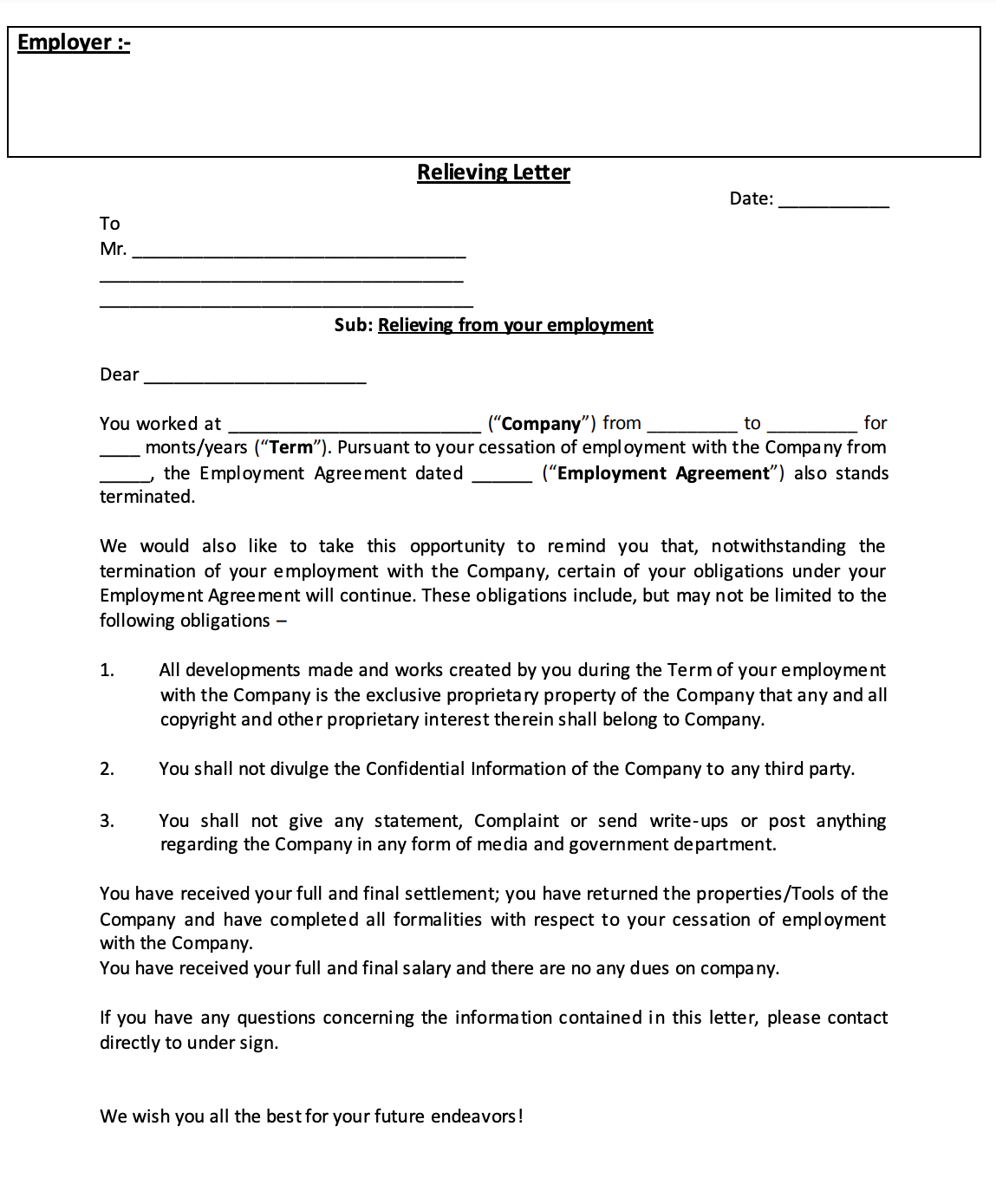
How to Write a Relieving Letter?
A relieving letter is an official document issued by the HR department or management confirming that an employee has been relieved from their job responsibilities and duties. Here’s a comprehensive guide on how to write a relieving letter that is professional, clear, and serves its intended purpose effectively.
Begin with Company Letterhead:
Always start by writing the letter on the company’s official letterhead. This imparts authenticity and a formal tone right from the outset.
Date and Employee Information:
Just below the letterhead, on the right or left-hand side, mention the date of issuance. Follow this by the employee’s name, designation, and department to personalize the letter and prevent any identity confusion.
Subject Line:
Craft a concise subject line that includes the term ‘Relieving Letter’ to immediately convey the purpose of the document.
Salutation:
Open with a formal salutation using the employee’s full name, such as “Dear [Employee’s Name],”.
Acknowledgment of Resignation:
In the opening paragraph, acknowledge that the company has received and accepted the employee’s resignation. Include the date the resignation was submitted and the effective date of resignation.
Statement of Relieving:
State clearly that the employee is being relieved from their duties. Mention the effective date of relieving which is usually the last working day of the employee with the company.
Appreciation and Contributions:
A short paragraph should be dedicated to appreciating the employee for their contributions to the company. Acknowledge specific accomplishments if possible or provide a general thank you for their service.
Settlement of Dues/Return of Property:
Confirm that the employee has completed all the tasks, returned company property if applicable, and that all financial obligations have been settled. This may include final salary, expense reimbursements, and other related dues.
Future Cooperation:
Offer assistance for any future verifications or inquiries from new employers. This is an important element as it facilitates the employee’s transition to new opportunities.
Well Wishes:
Extend good wishes to the employee for their future endeavors, signifying a positive end to the employment relationship.
Closure and Signature:
Conclude with a formal closure like “Sincerely” or “Best Regards,” followed by the signature and printed name of the company’s authorized signatory, their designation, and the date.
Proofread:
Before sending the letter, proofread it thoroughly to ensure there are no errors. The language should be formal and the tone should be positive.
Issue in a Timely Manner:
It’s important to issue the relieving letter on the employee’s last working day or shortly after to avoid inconveniencing their onboarding process with a new employer.
By following these guidelines, you can draft a relieving letter that is not only professional and courteous but also comprehensive and clear, ensuring a smooth transition for the employee as they depart from your organization.
7. Sample Relieving Letter
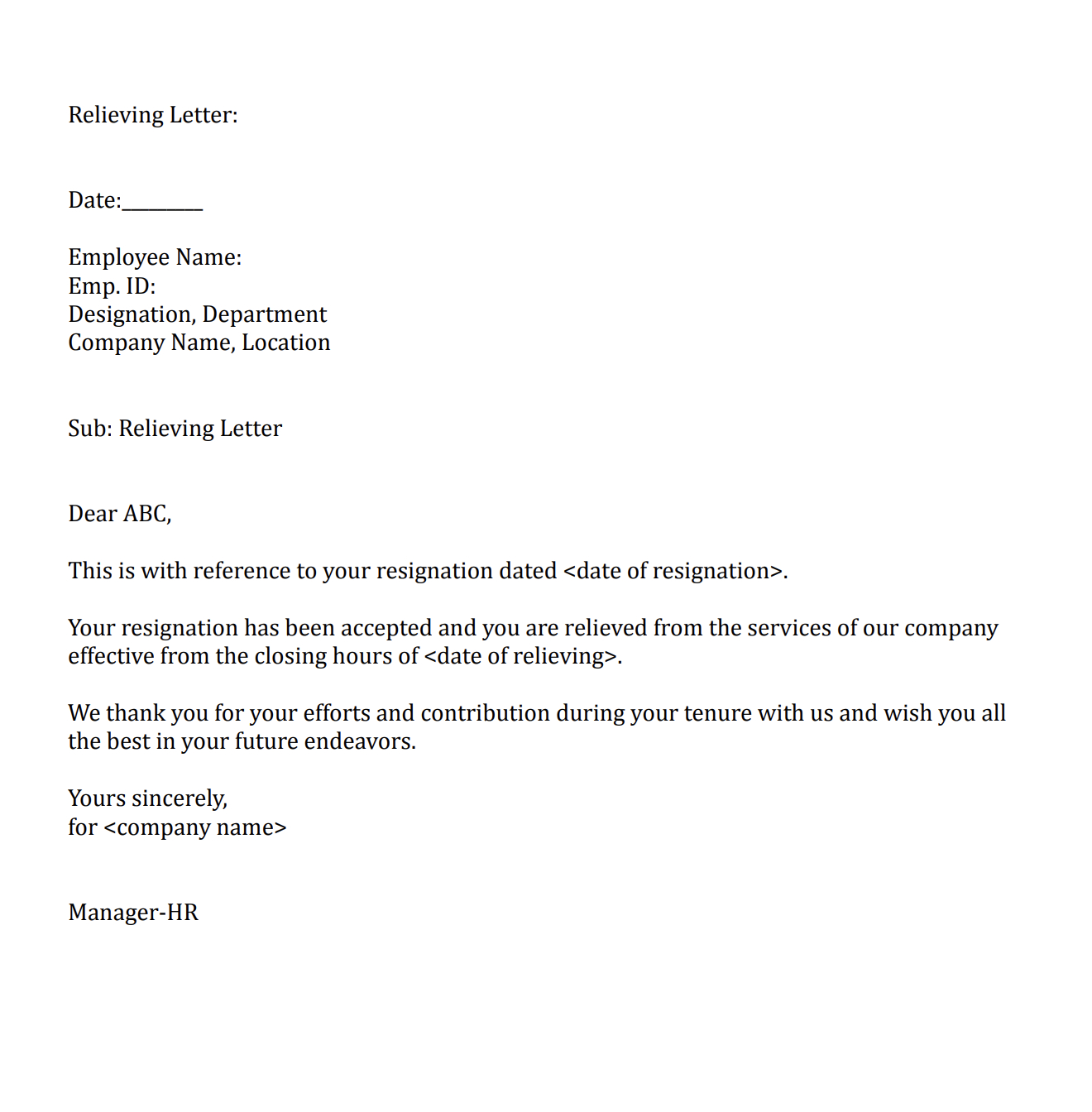
When should you receive a relieving letter?
Receiving a relieving letter is a significant event in the professional life cycle, marking the closure of your tenure with an organization. It is a formal communication issued by an employer to an employee that states the employee has been relieved of their duties. Understanding when to expect this document is crucial as it officially ends the employer-employee relationship and allows you to move forward in your career. Here’s a detailed look at when you should receive a relieving letter:
1. Post-Resignation Process Completion:
The process begins with the submission of your resignation letter. Once your resignation is accepted, and you have served the stipulated notice period, you should be in line to receive your relieving letter. The notice period is usually defined in the employment contract or company policy and typically ranges from two weeks to three months.
2. After Fulfilling All Obligations:
Before the relieving letter is issued, you must fulfill all your obligations. This includes completing all assigned tasks, returning company property such as ID badges, electronics, and any documents or materials you were responsible for during your employment.
3. Clearance of Financial Dues:
The finance department will usually need to clear you of any financial liabilities or confirm that all payments due to you have been settled. This could involve the final paycheck, reimbursement claims, or deductions.
4. Successful Knowledge Transfer:
If your role requires you to transfer your knowledge or responsibilities to another employee, the relieving letter is issued after the successful completion of this process.
5. Exit Interview Completion:
Many organizations conduct an exit interview to gather feedback on your experience with the company. Your relieving letter may be provided to you after this interview has been conducted.
6. After Documentation and Data Management:
You may need to assist in the documentation of your work and management of data you handled. Once the company is confident that all information is securely managed and handed over, they will process your relieving letter.
7. HR Clearance:
The human resources department often has a checklist for outgoing employees. Your relieving letter will be issued once HR confirms that you’ve completed all the steps on this checklist.
8. Before Joining a New Employer:
Ideally, you should receive your relieving letter before you join a new employer. This letter serves as proof that you are no longer legally bound to your previous employer, which is a reassurance for your new company.
9. Customary Waiting Period:
In some cases, there may be a customary waiting period after your last day at the company, during which your performance and conduct during the notice period are reviewed.
10. Company-Specific Policies:
Depending on organizational policies, the timeline for issuing a relieving letter may vary. Be sure to understand these policies so you can anticipate when you’ll receive the letter.
11. Legal and Contractual Obligations:
In jurisdictions or industries with specific legal or contractual requirements regarding employee exit, the timeline for receiving a relieving letter may be dictated accordingly.
It is important for employees to follow up with their HR department if the relieving letter is not received within a reasonable time frame after completing all exit formalities. A delay in receiving this document can potentially create complications in joining a new employer and should be addressed promptly.
Related Posts
Payment Letter Formats Samples & Templates
Business Proposal Letter to Client Samples & Templates
Company Introduction Letter Samples & Templates
Resignation Letter for Medical Samples & Templates
Letter of Intent Samples & Templates
Letter of Intent for a Job Samples & Templates
Lease Proposal Letter Samples & Templates
Letter of Inquiry Samples & Templates
Character Reference Letter Samples & Templates
Claims Letter Samples & Templates
Response Letter Sample & Templates
Follow Up Letter Samples & Templates
Sample Project Proposal Letter Templates
Donation Letter Samples & Templates
Addressing a Formal Letter Samples & Templates
